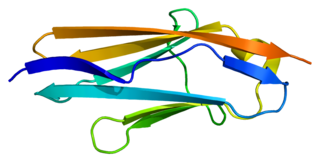
Ubiquitin carboxy-terminal hydrolase L1 is a deubiquitinating enzyme.

Parkin is a 465-amino acid residue E3 ubiquitin ligase, a protein that in humans and mice is encoded by the PARK2 gene. Parkin plays a critical role in ubiquitination – the process whereby molecules are covalently labelled with ubiquitin (Ub) and directed towards degradation in proteasomes or lysosomes. Ubiquitination involves the sequential action of three enzymes. First, an E1 ubiquitin-activating enzyme binds to inactive Ub in eukaryotic cells via a thioester bond and mobilises it in an ATP-dependent process. Ub is then transferred to an E2 ubiquitin-conjugating enzyme before being conjugated to the target protein via an E3 ubiquitin ligase. There exists a multitude of E3 ligases, which differ in structure and substrate specificity to allow selective targeting of proteins to intracellular degradation.

Growth/differentiation factor 5 is a protein that in humans is encoded by the GDF5 gene.

Probable G-protein coupled receptor 37 is a protein that in humans is encoded by the GPR37 gene.

Three prime repair exonuclease 1 is an enzyme that in humans is encoded by the TREX1 gene.

Lipopolysaccharide-induced tumor necrosis factor-alpha factor is a protein that in humans is encoded by the LITAF gene.

5'-AMP-activated protein kinase subunit beta-2 is an enzyme that in humans is encoded by the PRKAB2 gene.

DNA-binding protein A is a protein that in humans is encoded by the CSDA gene.

Alpha-1,2-mannosyltransferase ALG9 is an enzyme that in humans is encoded by the ALG9 gene.

CCAAT/enhancer-binding protein gamma (C/EBPγ) is a protein that in humans is encoded by the CEBPG gene. This gene has no introns.

EF-hand domain-containing protein 1 is a protein that in humans is encoded by the EFHC1 gene.

Krueppel-like factor 12 is a protein that in humans is encoded by the KLF12 gene.

Serine/threonine-protein kinase PCTAIRE-3 is an enzyme that in humans is encoded by the PCTK3 gene.

Leucine-rich repeat serine/threonine-protein kinase 1 is an enzyme that in humans is encoded by the LRRK1 gene.

Striated muscle preferentially expressed protein kinase, in the human is encoded by the SPEG gene, a member of the myosin light chain kinase protein family. SPEG is involved in the development of the muscle cell cytoskeleton, and the expression of this gene has important roles in the development of skeletal muscles, and their maintenance and function. Mutations are associated with centronuclear myopathies a group of congenital disorders where the cell nuclei are abnormally centrally placed.

Synaptotagmin-11 is a protein that in humans is encoded by the SYT11 gene.

Hedgehog interacting protein (HHIP) is a protein that in humans is encoded by the HHIP gene.

Dual specificity protein phosphatase 12 is an enzyme that in humans is encoded by the DUSP12 gene.

Neurogenin-2 is a protein that in humans is encoded by the NEUROG2 gene.

Zinc finger protein 300 is a protein that in humans is encoded by the ZNF300 gene. The protein encoded by this gene is a C2H2-type zinc finger DNA binding protein and a likely transcription factor.





















